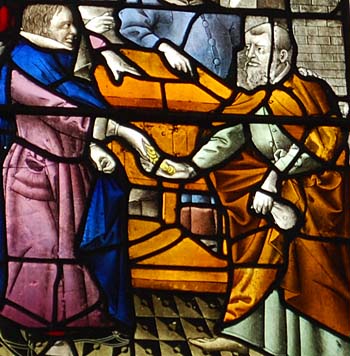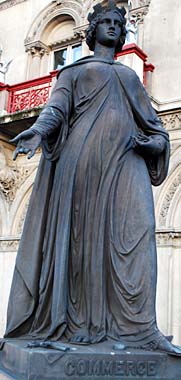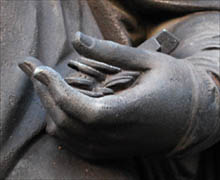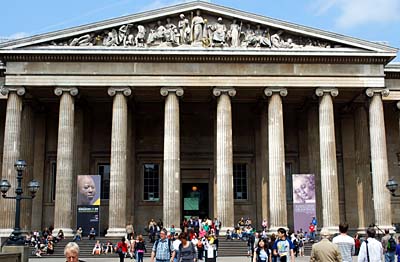As the initial phase of the transformation of England from a predominantly rural to an urbanized society, the Middle Ages saw not only a substantial growth in, and infiltration throughout the populace of, commercial activity and infrastructure, but also shifting attitudes towards the leading agents of commerce.
The Bible provided ample grounds for churchmen to feel concern, even hostility, towards those who accumulated inordinate riches, for it pointed to the mortal sin of covetousness. Furthermore, in the person of Judas, who sold Jesus to his persecutors, there was a powerful example of how money could corrupt the soul. Yet money was not seen as inherently evil; if applied to good works, as opposed to being desired for its own sake, wealth was not necessarily an obstacle to salvation, and some ecclesiastics acknowledged that even a Judas could fulfill Divine purpose. This provided a loop-hole through which Catholic social theory might be brought more in line with the realities of a commercializing society.

Photo © S. Alsford
Judas receiving his thirty pieces of gold, depicted in
a late fifteenth or early sixteenth century panel of stained glass now in the window
of Lady Chapel, Exeter cathedral (although not originally produced for that
setting).
One way in which the Church attempted to exercise social control was by promoting a theory of social structure in which there were three essential roles – to pray, to fight, to work – and urging particularly members of the last category within this society of mutually dependent unequals to be content with their lot in life. But medieval society was becoming a rather more complex structure that provided potential for, and benefited from, social mobility; from about the thirteenth century this pushed philosophers towards more sophisticated theories. The idea that people should content themselves with acquiring just what was sufficient to keep them alive (for life was seen as only a transitional phase and it was the well-being and destiny of the soul that was important) gave way to appreciation that accumulation of wealth could have beneficial consequences for society, if part of that wealth were dedicated to charitable works – spreading wealth amongst the poorer members of society – and to financial support of the infrastructure of Catholic worship designed to assure spiritual salvation.
By the fifteenth century, poverty was no longer lauded as an ideal (indeed, beggary had now become the target for disapproval), and those who accumulated wealth and used it well could become models to be praised, respected, and emulated. This reversal did not extend acceptance to illicit or immoral means of acquiring money – that is, to tactics used by traders to gain more than fair market price (which itself accommodated a certain remunerative profit margin) – or indeed to mercantile methods in general, but only to the acquisition and deployment of wealth; merchants' wills provide evidence that many were concerned to rectify suspect means with good ends, even though the Church was skeptical about the spiritual value of post-mortem charity, especially if funded from ill-gotten gains. Yet a number of the wealthier merchants also channelled significant amounts of their time, energy, and money into charitable acts or public-spirited projects during their lifetimes.
The development of a rationale for the existence of a mercantile class within society was bolstered by other factors. One was the rediscovery of Aristotle's secular philosophy of society; even after its reconciliation with Christian morality, there remained his arguments that commerce was an activity inherent to social relations, and one of the fundamental purposes of urban communities. A second factor, perhaps even more influential, was the growth of civic pride, tempered by humanist philosophy's endorsement of personal prosperity, the latter pre-figured by Giles of Rome's argument, based on Aristotelian thought, that cities represented a superior form of social collective because, by providing the crafts and commerce that met the material needs of humans, it established the conditions of physical comfort that enabled them to strive towards spiritual virtue.
These cultural underpinnings allowed merchants to perceive themselves as valuable contributors to society, benefactors of their communities, whose public works justified their accumulation and even display of wealth, measured monetarily. Unsurprisingly, it was in the merchant-dominated cities of Italy that pro-mercantile theory was first developed in detail. This theory filtered into English attitudes through writings that included Caxton's editions of continental works, such as The Game of Chess, which recognized both that merchants could be honest and that they were essential to the state by generating wealth.

Statue to Commerce, London
Photo © S. Alsford
By the nineteenth century the role of commerce had become so central to the well-being of the nation, and indeed a key characteristic of Western culture as a whole, that a statue, albeit allegorical, could be raised to it in England's capital, personifying commerce as if some kind of idol or deity. The roots of this process can be traced back into the Middle Ages, although at first authorities looked upon commerce with a certain amount of suspicion, or even distaste.
Those hostile feelings were perhaps most strongly expressed through the Church, whose attitudes were shaped partly by the Biblical role of Judas Iscariot, establishing a negative archetype for commercial activity. By the close of the Middle Ages merchants – or at least those who were financially successful – had attained a position of respectability, not only for their commercial knowledge and acumen but also for their leadership of society and their investment in its fabric. The new archetype was more along the lines of a Dick Whittington, who attained legendary status in popular culture and remained iconic well into the twentieth century; he has been the subject of several public statues. Although there remained detractors willing to condemn the covetous and cheating behaviours of traders, for the greater part of the population commercial accomplishment was something to which to aspire, the mercantile speculator an almost heroic figure to be emulated and to be judged by their own standards rather than those of Catholic morality.
The statue of Commerce is one of several by Henry Bursill (ca.1870) placed on the parapets of Holborn Viaduct, a Victorian bridge built across the valley through which ran the River Fleet (culverted by that time). The group comprises two pairs of female figures: on the north side the statues personify Science and Fine Arts, while those on the south side personify Commerce and Agriculture. Commerce wears a crown, indicative perhaps of the status of the city or of the sovereign importance of merchants, and proffers coins and gold with one hand; the other hand is extended in welcome to immigrants. At her feet are the keys of the city and a parchment representing a grant of citizenship. The statue thus associates citizenship and commerce, and symbolizes the role of resident burgesses in building the prosperity of a city given economic privileges by the monarchy. Bursill also sculpted statues, placed on buildings constructed at either end of the Viaduct, of several leading citizens who contributed to the development of London's prosperity: medieval mayors Henry fitz Ailwin and William Walworth, and Tudor merchant-financier Sir Thomas Gresham (a man in the Whittington mould).

Coins in the hand of the statue of Commerce.
Photo © S. Alsford
A couple of decades earlier statues to Whittington and Gresham had been installed, significantly, on the facade of London's Royal Exchange, a key institution in English commercial culture. The Exchange did not exist in Whittington's lifetime; it was founded (1565) instead by Gresham, on a scheme of his late father, a one-time mayor, as a financial trading centre combined with a precursor to the modern shopping centre (in which latter form it still operates). A statue of Gresham had adorned his original building. Whittington's statue on the current Exchange building is not entirely inappropriate, however, for both he and Gresham were members of the Mercers' Company, active in the cloth trade with Flanders, the Antwerp Bourse being the model for the Royal Exchange; the Company and the city itself, both of which had donated parts of the site of the building, were Gresham's joint-heirs to the Exchange. Furthermore, Whittington was, in the early fifteenth century, instrumental in acquiring and donating to the city the site of Leadenhall Market, a location where fish, meat, poultry, cheese, and grain were already being sold, and where later in the century another city clothier constructed a market building and a chapel to serve market users, the trone for weighing wool being subsequently transferred there; a stretch of the market is still known as Whittington's Avenue.
The Victorian version of the Royal Exchange, designed to resemble a temple to commerce, is part of the same cultural mindset that produced the statue to Commerce. An inscription placed within the Exchange's foundation stone, along with a bottle containing coins, included the opinion that the building design was "suited to the vastness of a Commerce/ Extended to the circumference/ Of the habitable Globe". The keystones have carved into them the merchants marks of Gresham and contemporary Merchant Adventurers. The frieze above the portico features the figure of Commerce, again crowned, holding the foundation charter of the Exchange, flanked by English and foreign merchants, some associated with packages of merchandize.

Entrance facade of the Royal Exchange, London
Photo © S. Alsford
Not far off, Great St. Helen's church, Bishopsgate, whose patrons are the Merchant Tailors, houses the tombs of Gresham and several other prominent merchants, such as cloth merchant Sir John Crosby (d.1476) and skinner SIr Andrew Judd (d. 1550), both mayors of the Calais staple. On a wall monument there to William Bond (d. 1576), depicted in traditional pious pose, the inscription reads "Here lyeth the body of William Bond, Alderman and sometime Sheriff of London, a merchant adventurer, and most famous in his age for his great adventures both by sea and by land." Such impressive tomb monuments had at one time been associated only with the aristocracy; but leading merchants, the commercial aristocracy, could by the Late Middle Ages both afford and desire such memorials.
During the greater part of the medieval period sculptures and two-dimensional depictions of Biblical characters, figures of legend, or of monarchs were not uncommon in England, but it was barely conceivable that a portrait might be painted of, or a statue raised to, a merchant (unless perhaps an allegory), let alone to a personification of commerce. By the close of the Middle Ages attitudes towards commerce and merchants were clearly changing. A distinctive, self-conscious, and to some extent self-contained merchant class was emerging within English society, practically as a sub-culture: less than noble (though in some instances upwardly mobile), yet more than rank-and-file burgess, an urban gentry. This class dominated cities and towns, economically and politically, and had added a new dimension to the position of London as the nation's capital; it was also participating in national government, alongside the rural gentry, through parliament.
The merchant's enhanced status derived not simply from the acquisition of wealth and power, but also from growth in respect for, and in prestige of, an occupation whose pursuit was recognized as bringing prosperity to the nation. The importance of the merchant class was reflected: in the adoption of identifying devices – initially merchants' marks (applied to properties, possessions, and wares) and later heraldic shields; in their tomb monuments – at first brasses, then three-dimensional representations; and in depictions of them in stained glass windows, and even in secular works, such as in Ricart's calendar, the series of portraits of London aldermen, and woodcut illustrations in early printed books (some of which Caxton was targeting specifically at the merchant class). The groundwork for this shift in attitudes towards commerce and merchants was laid, slowly, over the course of the later Middle Ages.